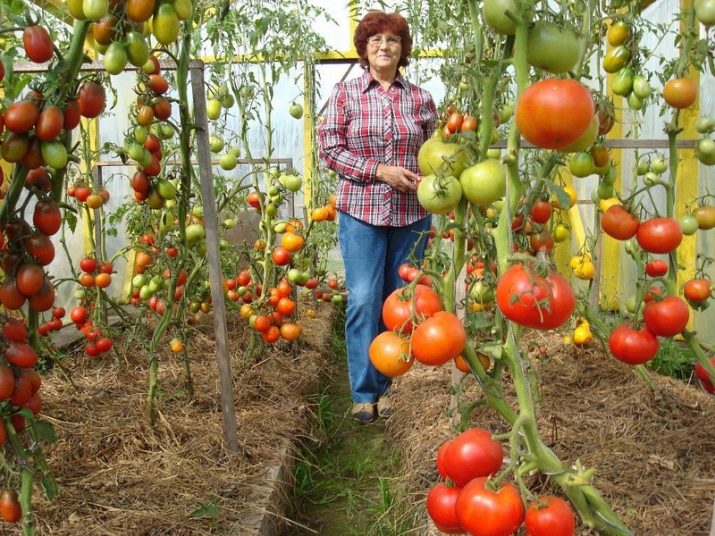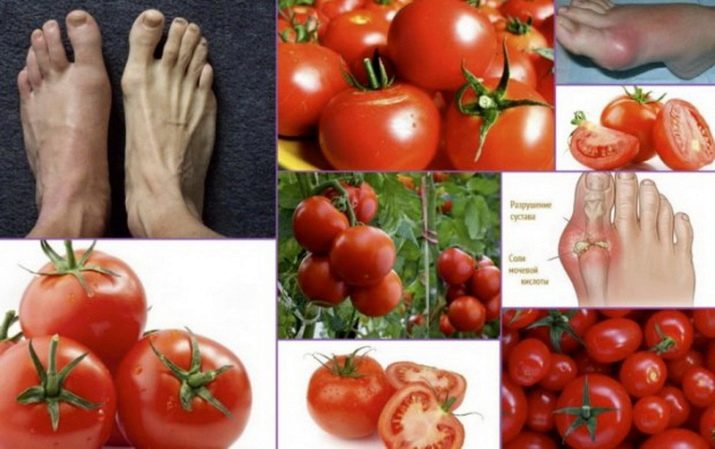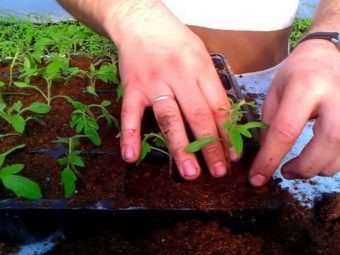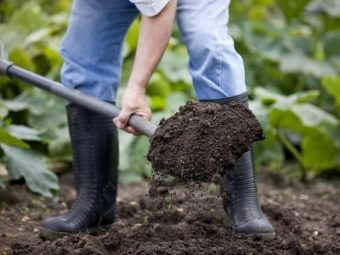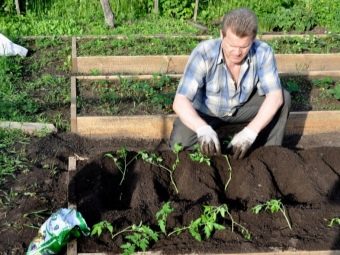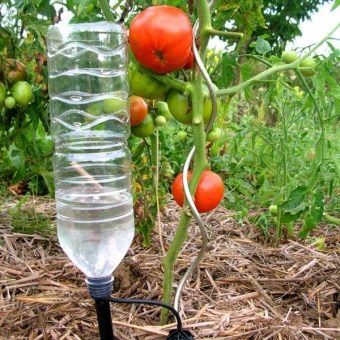Tomato "Sanka": description of the variety and characteristics of cultivation
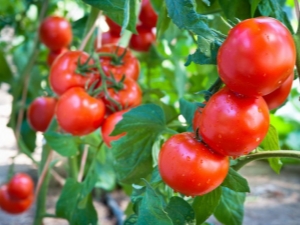
A tomato is a fruit that is very much in demand in our time.The tomato can have fruits of the most different form: round, oval, oblate and heart-shaped.
There are many varieties of tomato, from each other they can be distinguished not only by shape, but also by size, color, description. Tomatoes can also have different types of bushes and fruit ripening time. Which of the varieties to give preference, you decide, but first you should familiarize yourself with the characteristics and characteristics of growing these plants in order to get the desired result.
Each gardener wants to get a bountiful and early harvest, so for this purpose tomato variety "Sanka" fits perfectly. He is familiar to owners of cottages and household plots since 2003. Work on the cultivation of this variety of tomato was entrusted to the scientist E. N. Korbinskaya. Today the variety is distributed under the name "Sanka". Aelita company sells these seeds.
A large and appetizing fruit of this type can be not only red, but also yellow in color, as it has an excellent hybrid - “Sanka Golden”. It is almost as good as its predecessor. The plant is rarely sick, so it is especially valued among gardeners. The tomato can be used not only for cultivation on the personal plot, but also for industrial purposes.
Main characteristics
Tomato "Sanka" refers to determinantal plants. A tomato that is grown in open soil can have a bush height of up to half a meter. A greenhouse plant may be slightly larger, but no larger than a meter in size. Pasynki are the places where new fruits will be formed, therefore this tomato does not need to be removed, which can also be attributed to its merits. The formation of the first brushes can be seen at the time of the development of this seventh leaf.
The grade is characterized by average productivity. Fruits begin to form after 80 days from the moment of emergence. The process of ripening begins after 100 days from germination, it is quite fast and uniform. Each tomato has a smooth round shape. It is covered with a thick bright red skin. If green tomatoes are picked, they will quickly reach the table and will not lose their taste.
The weight of each fruit is about 80 grams, the structure is not watery, which distinguishes this variety from other early ones. Shrubs non-hybrid plants have intermediate inflorescences and they almost do not need a garter. "Sanka" is quite resistant to cold, for maturation he needs a little sunny color. The variety is characterized by high yield, which can be about four kilograms per bush. With the help of seed collection, it will be possible to plant the tomato next year and get a decent harvest.
"Sanka Golden" is a hybrid and can give a lot of fruit, regardless of the place of growth. This high-yielding and unpretentious tomato is popular among summer residents. It was bred by Russian breeders on the basis of the Sanka variety. The look has excellent taste characteristics and original yellow color.
After 80-90 days after the appearance of the sprouts, the tomato gives fruit. Their shape is round, has a rich color, fleshy and juicy flesh. With proper care, the variety yields a yield of 15 kilograms per plant for the entire season. "Sanka Golden" is good for shaded areas. Its fruits can be used for a variety of purposes. This is due to the high content of useful elements:
- vitamins A, groups B, K, E;
- fructose, malic, citric and oxalic acid;
- iron, zinc, magnesium and iodine;
- glucose and ascorbic acid.
Due to the fact that the fruits ripen in unison, their urgent processing is not necessary. In summer, you can make gazpacho soup or pizza sauce. This vegetable is characterized by its strength, which is why it is used in stuffing. Several options for filling:
- with cheese, mayonnaise and garlic;
- with cottage cheese, greens, garlic and sour cream;
- with cheese, dill, green onions, black pepper, sour cream.
Reviews on the web about this variety of tomatoes are only positive. People who grow it in the Moscow region, harvest good yields by mid-June and are very pleased with the result. Others are pleased with the commodity attractiveness of the variety and the fact that it can be torn pink, and when it ripens, the tomato will be no less tasty than the fruits ripened on the branches.
Advantages and disadvantages
This low-growing plant can enjoy fruits until the onset of cold weather. In addition, "Sanka" has a lot of other advantages:
- fast ripening period;
- good harvest in all weather conditions;
- indifference to the level of soil fertility;
- does not need to be staved;
- growth of bushes is possible without supports and without a garter;
- the fruit is characterized by beauty, pleasant taste and long lies;
- seeds can be used to plant this type of tomato;
- during transportation the fruits do not deteriorate;
- multipurpose use.
This fruit is endowed with a mass of beneficial properties for humans:
- is an antioxidant;
- prevents the breakdown of cells in the body;
- normalizes the work of the heart and blood vessels;
- has a diuretic ability, is involved in metabolism, is useful for use to those people who are overweight;
- considered an excellent antidepressant and normalizes the nervous system;
- supports immunity and gives the body extra strength and energy;
- tomato can kill harmful microorganisms and show anti-inflammatory effect;
- quenches thirst and reduces pressure;
- It has a beneficial effect on metabolism, can neutralize toxins and eliminate cholesterol;
- by eating a tomato, the face becomes fresh and young;
- vitamins contained in tomato, contribute to the improvement of vision and treatment of eye diseases;
- Tomatoes improve memorization and ability to assimilate information.
Tomato "Sanka" has found its use in many areas:
- This is an indispensable food in the kitchen of different countries of the world. Soups, salads, juices, casseroles, preserves, ketchups and snacks are made from it. Eating tomatoes may be processed and raw.
- Due to the low calorie content it is recommended to use during diets.
- Juicy pulp is used to treat burns, wounds.
- Fruits make facials that promote skin rejuvenation.
- Tomato leaf - the raw material for the preparation of toxic chemicals.
This variety of tomatoes is not noticed flaws. But there are some contraindications for its use in food. The organic acid of this berry aggravates the diseases of the liver, gall and bladder. Tomato can cause an allergic reaction. For people who have arthritis and osteochondrosis, this berry is contraindicated.
It is strictly forbidden to use tomatoes with alcohol.
How to grow?
Cultivation of tomato “Sanka” is possible with the use of seeds that can be purchased or procured independently. The result of your work in the garden will depend on how well the material for planting will be prepared.
Prior to the beginning of the sowing process, it is worth sorting out the seeds, removing the defective ones from them. Select for the process you need not damaged and high-quality copies. Seeds need to be pickled before the sowing procedure, for this they are soaked in a solution of potassium permanganate and left for some time. After the material is rinsed. The use of growth promoters will also benefit the future harvest. It is recommended to use "Zircon", "Oberg" or "Ecosil".
It is necessary to calculate the optimal time for planting seed. In order for the seedlings to reach the level of development they need for transplanting, it will take 50 days, then it can be transplanted.
Planting material is dried and seeded in containers that are filled with earth. Seeds should be covered with soil no more than one centimeter. Before planting, the ground must be moistened and loosened.
Picking will be the next stage in the germination of tomatoes.His conduct is required. The function of the dive is to stimulate the root system of plants. In order to begin the procedure, a tomato should have two leaves. The seedling needs to be transplanted in separate cups and deepened to the foliage. It is also recommended to fertilize the soil with minerals. Ten days later, urea, superphosphate or sodium phosphate can be added to the growing tomatoes.
After about 1, 5 months the seedlings will be ready for transplantation. This will be noticeable in a plant that has six or seven leaves, as well as well-developed roots. Young growth will be considered hardened if every day it is briefly brought to fresh air.. An important point before planting is the selection of the best individuals, which have the strongest root system and strong escape. A tomato with a height of about 30 centimeters is considered ready for planting.
Seedlings are planted in open ground or a greenhouse in the amount of 9 plants per square meter. This work is best done in the evening or in cloudy weather. Do not forget about the warming of the earth to the depth of the root system, its temperature should not be below 15 degrees. At lower temperatures, the plant may not settle down.
The process of planting seedlings in the greenhouse can begin from the first of May, under the film - from 20, but in the open ground - approximately from 10 June. The main thing is that there is no return of frost. The best place to grow tomatoes is where cabbage, cucumber, carrots and onions used to grow.
Proper soil preparation is as follows:
- Sanding. It should be carried out in the autumn. If the ground is heavy and wet, then a bucket of sand per square meter of territory will suffice.
- Liming. Reduces soil acidity. During the digging of the soil in the soil is lime powder in the amount of 800 g per square meter.
- Disinfection. In spring, the soil can be treated with a hot solution of copper sulphate with the calculation of a liter per square meter.
- Introduction organic and mineral fertilizer.
Immediately before planting the seedlings it is necessary to form the beds. Their optimum size is 1-1.2 meters in width and 0.2 meters in length. The wells are made at a distance of 0, 4 meters in a row, and between rows - about 0.55 meters. After preparing the beds, you can start working with seedlings. If the plant grew in a paper cup or peat tablet, then it can not be removed. Provided that any other container was used, the tomato is carefully removed from it using a spatula.
The seedling is located in the hole in an upright position and filled with fertile soil to this leaf. Next, the earth is pressed and watered.
To grow tomato "Sanka" in a greenhouse, you need to take into account some features, such as the quality of the soil. It is necessary to mix two parts of the land from the garden, one part of peat, the same share of sawdust and humus. The procedure of planting plants in the soil is identical with the previous version.
This variety is created for growing in the central black earth regions, which does not mean that it can not be grown in another locality. Tasty tomatoes can be collected in any region of the country. But if it is northern, the plant will need shelter in case of cold.
Care rules
Tomato is a culture that can be found in almost every garden. For a bountiful harvest, caring for a grade is worthwhile correctly and regularly. Start caring for a plant is necessary when it is in a state of seedling. Young shoots should be provided with enough light, moisture and regularly hardened.
Despite the fact that “Sanka” is an unpretentious variety of tomatoes, it must be constantly fertilized and watered, to form a bush and remove the yellow leaves that have appeared.
If you water the tomatoes properly and in a timely manner, they will grow well.When growing a plant in a greenhouse, fruit cracking is often noticed. The formation of furrows occurs on them, which dry up over time, which causes a blow to the crop. The reason for this condition is a violation of watering during growth.
To carry out watering the culture preferably once every 3-4 days. At the same time, water should be poured into the well, so that the liquid gets to the right place and it does not spread over the ground. Seedlings should be planted in moist soil. After the bush is placed in the ground, it is watered again. Re-irrigation can be done after seven days. During this period, the roots will become adapted to the new habitat and begin a normal and full-fledged process of life activity.
Watering can be of these types:
- mechanical;
- sprinkler;
- drip;
- subsoil.
If there are a lot of plants, then watering them will take a lot of time, so mechanical irrigation here will be most appropriate. At the cottages are often used hoses that connect to the water supply. If the water pressure is too high, it can damage the wells and they will have to be restored. Therefore it is necessary to ensure that the pressure was optimal. It is also undesirable that water gets on the leaves.
Automatic irrigation systems can be installed both in the open field and in the greenhouse. At home, you can build a drip irrigation with your own hands, which will ensure uniform moisture penetration to the roots of Sanka.
In order to build a subsurface irrigation system, it will take more knowledge and effort. It consists of a system of pipes placed inside the soil. It is necessary to carry out such irrigation along the distribution rows so that the liquid flows strictly under the roots.
The most advanced type of irrigation includes rain irrigation system, which is often applicable in greenhouses. This irrigation process consists in placing pipes with nozzles at a certain height. Such equipment contributes to the uniform distribution of moisture and prevent its oversupply.
When watering, be sure to follow the schedule to prevent over-wetting of the soil and the spread of some fungal diseases of plants.
The procedure of caring for tomato "Sanka" includes the timely application of fertilizers in the soil or in each well. If the plant is fed incorrectly, then it can cause irreparable harm.
For the first time the soil is fertilized before planting tomatoes. Due to this, it is enriched with organic substances, minerals and useful elements that will contribute to good yields. The next fertilization should be carried out after the seedlings have taken root and began to grow in the ground. The third time, after the fruit begins to be tied.
Ammonia and calcium nitrate are well suited as fertilizer in the amount of 0.5 kg per hundred. She poured into each well, and then filled with water. When the two media come into contact, the chemical element will quickly sink deep into the earth. Chemicals can be used not only in powder form, but also in liquid form. They are usually diluted with water, and then poured under the wells.
During the cultivation of tomato "Sanka" you should not overdo it with the amount of fertilizer. If the soil is sufficiently fed, the first dressing is optional.
When the cultivation process takes place at home, the quality of the soil should be given special attention. He always needs additional loosening in order to get better air and moisture.
Diseases and pests
Tomato "Sanka" is considered quite resistant to a variety of diseases that can attack tomato bushes. But still it is recommended to carry out prevention against such diseases:
- Blackleg. The defeat of seedlings occurs due to frequent irrigation and lack of fresh air.
- Dry spot. This type of disease belongs to the fungal.Affected shrub needs careful removal and destruction far from other plants to prevent the spread of the disease.
- Black spot.
If, nevertheless, the plant is affected by the black leg, it is necessary to immediately prevent further development of the disease. To do this, reduce watering and treat plants with a weak solution of potassium permanganate.
To carry out prevention against fusarium and late blight, it is necessary to water the soil with diluted potassium permanganate once every 10 days. From the whitefly, caterpillar-moth and other pests should treat the plant with insecticides.
As a means of prevention, agronomists often use a change in the top soil layer. The rest of the earth is carefully digged. Tomato "Senka" can suffer from such pests:
- Aphid. To combat it, it is necessary to water the plants under high pressure. It is necessary to carry out this procedure every day. So the pest will gradually be washed away until it completely disappears. It is also recommended to break the foliage with the accumulation of aphids or the use of chemicals.
- Caterpillars They can attack plants in greenhouse conditions. The method of disposal of them is considered to be a regular collection of weeds, as well as scalding of the soil with boiling water just before planting.
- Colorado beetle. If tomato bushes are attacked by this pest, then the same means as for the protection of potatoes can be used.
Useful tips
For a good harvest you need strong and healthy seedlings. Here are some tips to help young plants get better:
- do not ignore seed treatment with potassium permanganate, as this process will reduce the possibility of infection of seedlings with fungi;
- be sure to do a pick of a seedling;
- thanks to artificial lighting, seedlings are not drawn out;
- night temperature in the room where cultivation is carried out, should be lower than during the daytime;
- the soil needs regular loosening;
- at risk of frosts, it is worthwhile to mulch the soil or cover the plants with a white non-woven fabric;
- it is impossible to plant a “Sanka” in the place where potatoes grew last year;
- It is better to use organic options fertilizing.
If seeds are bought in a store, the choice is only to stop at a proven and reliable manufacturer, which will guarantee a quality result. There are situations when the first fruits of the variety correspond to the size of the species, and the rest grow smaller. This indicates a lack of nutrition of the bushes and the need for their urgent feeding. Alternatively, you can use potash phosphate fertilizer. But in any case it is not necessary to overdo it with top dressing, since the fruits can turn out watery.
Tomato "Sanka" - a variety suitable for all. Experienced farmers prefer it, and beginners often grow, knowing its excellent characteristics. It is popular as it is undemanding in leaving, it is enduring, unpretentious and gives a good harvest.
This variety of tomato can be grown in greenhouse conditions and on open soils. If there is no specially designed place, then the Sanka will be able to please you with a crop, growing right on the balcony or windowsill. This variety of tomato is eaten raw and canned, so all year round you will enjoy this unusual culture.
There are many varieties of vegetables that are grown in the garden a year, sometimes five years, and then disappear and people forget about them. But this can not be said about the tomato "Sanka". It belongs to those rare plants that, when they hit the land, become permanent residents on it.
Review the characteristics of tomato varieties "Sanka", see the following video.


